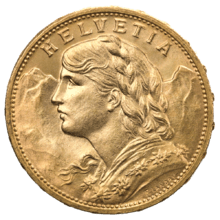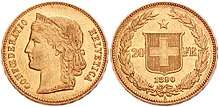Vreneli
Vreneli (aka Goldvreneli[1]) is the informal name for a range of legal tender gold coins produced in Switzerland. The formal name is Helvetia Head (Helvetiakopf in Swiss German, Tête d'Helvetia in French, as opposed to the Seated Helvetia (Sitzende Helvetia, Helvetia assise) or the Standing Helvetia)[2]. The coins were issued between 1897 and 1936, in 1947 and in 1949. All coins issued after 1936 are restrikes (legal tender ceased September 29, 1936).[3]
Switzerland | |
| Value | Swiss franc |
|---|---|
| Edge | minted |
| Composition | .900 gold |
| Years of minting | 1897–1936, 1947, 1949 |
| Obverse | |
 | |
| Design | Coat of arms of Switzerland |
| Reverse | |
 | |
| Design | Helvetia |
| Designer | Fritz Ulysse Landry |
| Design date | 1895 |
Description
These coins had face values of 10, 20 and 100 Swiss francs and were minted in a millesimal fineness of 900. The coins are sometimes colloquially called “Swiss Miss,” from the obvious obverse motif. The 20 franc coin's reverse shows the Swiss shield, featuring the Swiss Cross, and a wreath of oak along with the denomination. The coins were minted at the Swiss Mint at Bern (although the die engraving was done at the Paris mint) and the coins are mint marked with a "B" (without a period). The 20 franc coins are 21 mm in diameter (about the size of a U.S. five cent piece), 1.25 mm in thickness, weigh 6.45 grams (gross weight) and; at 90% pure, contain .1866 troy ounces or 5.805 grams of pure gold. The 10 franc coin weighs 3.23 grams and at 90% purity contains 2.9 grams (0.093 ozt) of pure gold.
| Letter | City | Letter | City | Letter | City |
|---|---|---|---|---|---|
| B | Bern | B. | Brussels | BB | Strasbourg |
| AB | Strasbourg | A | Paris | L | lingot/bullion re-strikes |
Years of issue
The coins were issued between 1897 and 1936, in 1947 and in 1949.
Key mintage figures
Around 61 million coins were minted, although only 5,000 of the 100 franc pieces were produced and only in the year 1925. The 20 Franc coin is the most common, and it is popular as a bullion coin. However, the coins also hold a place in numismatic circles.
1926 - 20 francs
Among the 20 franc pieces, the 1926 coin with its mintage of only 50,000 pieces is the ostensible key to that series. However, the 1926 is relatively fairly common and the real keys to the series are said to be the 1903 and the 1904. This is based upon the fact that the major coin grading services have graded less than 10 coins of each date in all grades, while the 1926 has a graded population of over 200.[4][5] Of course, populations depend upon the numbers of coins actually submitted by collectors which is inexorable tied to the popularity of a coin series, or lack thereof among collectors. For a critique of population reports see Doug Winter's essay, February 2002.[6]
1925 - 100 francs
The 100 franc denomination was only struck in 1925 with a very limited mintage of 5,000.
The 10-franc series
The 10 franc denomination was struck in 1911 (100,000) through 1916 (130,000), inclusive, and in 1922 (1,020,000). Although the obverse is the same for the 10, 20 and 100 franc pieces, the reverse of the 10 and 100 are common depicting a radiant Swiss Cross above a branch.
The re-strikes of 1935
In 1935, 175,000 regular strikes of the 20 franc coins were produced. However, an additional twenty million (20,008,813) coins dated "L1935B" with the "L" indicating "lingot" or bullion and the "B" indicating the Bern mint, were re-struck in 1945 (3,500,000), 1946 (7,108,813) and 1947 (9,400,000). An additional 9,200,000 coins contemporaneously struck and dated in 1947 were also produced and are distinguished by the mint mark "B". There were no regular strikes produced in the years 1945 and 1946.[7]
Historical notes about the coin design

This coinage series was authorized by the law on January 6, 1896. The name of the coin is a Swiss German affectionate diminutive of the female given name "Verena"[8]. This name, in its diminutive form also used as a pars pro toto for female youths, is historically well-known and traditionally popular in Switzerland. In an affectionate way it designates here a personification of the Confederation of Switzerland in the female effigy, (similar to the French Marianne or the American Lady Liberty). The coin shows the profile of a young female with braided hairstyle, a garland of edelweiss on her left shoulder and an alpine panorama in the background. The young female shown on the obverse of the coin was most likely modeled in 1895 either by Françoise Kramer-Egli (aged 36 back then) or Rosa Tännler (aged 17) from the Oberhasli district[9]. The Hasli region had a particularly strong tradition of independence. However, the name of the design could also have roots in the tale of William Tell, in which a character named "Vreneli" appears. The coin is also known as a Helvetia from the inscription above the portrait. Helvetia actually connotes two ideas: it is a variation of the official Latin name of Switzerland, Confoederatio Helvetica or Swiss Confederation, and, by extension, it refers to the allegorical figure of the Swiss version of Lady Liberty. The Helvetia figure is often depicted with a tiara with the word "Libertas" the Latin root for Liberty, as depicted on an earlier version of the denomination and known as the "Liberty head" (Libertaskopf in Swiss German, Tête de Libertas in French). The coins issued between 1897 and 1949 were designed by Fritz Landry of Neuchâtel, Switzerland, whose signature, "F. Landry" appears on the coin under the portrait. The edge of the coin is imprinted with stars in relief.
"The euro before the euro"
The 20 franc denomination with the aforementioned specifications (size and alloy and gold content) was first established by Napoleon for France in 1803. The denomination/specifications remained in usage until the First World War under what was known as the Latin Monetary League, the "euro before the euro", so-to-speak. Switzerland constituted itself in Confederation in 1848. It adopted the Swiss Franc, and aligned its currency on the French franc in 1850. It joined the Latin Union in December 1865. Switzerland had Swiss 20 franc pieces, Spain had 20 peseta coins, Italy had 20 lira pieces, Belgium had 20 Belgian franc coins, Romania had 20 lei coins and Greece had 20 drachmas coins all of which circulated and were accepted throughout Europe. Only for political reasons did the British and the German Empires refuse to follow this direction. Attempts were even taken to explore the unification of the European currency with the American dollar, which explains the extremely rare U.S. Stella carrying an unusual face value of $4, but which contained the same amount of gold as the 20F Vreneli.

An earlier Swiss gold coin had been issued between 1883 and 1896. This gold coin which on the obverse depicts an allegorical figure representing liberty ("Libertas"), is usually called "HELVETIA".[10]
Origin of gold
It has been reported that some of the gold used for the coinage of Vrenelis originated from the Peruvian Madre de Dios region, where its current exploration is often undertaken using toxic materials and without formal concessions resulting, as a consequence, in environmental damage and health issues for the miners.[11]
See also
- Coins of the Swiss franc
- Napoleon (coin)
- Rappen
- Swiss franc
Notes and references
- Das Goldvreneli, swissmint.ch
- PRÄGUNGEN VON SCHWEIZER MÜNZEN AB 1850 - FRAPPES DES Pièces de Monnaie Suisses à partir de 1850, Swissmint
- "List of the Swiss coins having legal tender and withdrawn from circulation" (PDF). Archived from the original (PDF) on 2013-10-13. Retrieved 2013-12-19.
- PCGS Populations report for Switzerland
- NGC Population reports for Switzerland
- Are Population Reports Useful
- Numismatica e storia. "Swiss gold coins (1883-1949)". Retrieved 27 September 2017.
- "Das 20-Franken-Stück von Landry wurde nicht immer "Vreneli" (schweizerdeutsch, Verkleinerungsform von Verena) genannt." Die Helvetia ein Vreneli? on page 7 in: Das Goldvreneli, swissmint.ch (in German)
- " Danach soll das Modell des "Vrenelis" entweder Françoise Kramer-Egli (1859 – 1946, aus Neuenburg) oder Rosa Tännler (1878 – 1946, aus Gadmen in Oberhasli) gewesen sein. Auf Grund von Aktenhinweisen erscheint die Variante Tännler glaubhafter, spricht doch der Künstler Fritz Landry 1895 in einem Brief an Bundesrat Hauser, dass er für seinen über-arbeiteten Entwurf einen "type de femme très pur du Hasli" studiert habe." Wer stand für das Vreneli Modell? on page 8 in: Das Goldvreneli, swissmint.ch (in German)
- "Nicht als Vreneli bezeichnet werden die 20-Franken-Goldmünzen, die in den Jahren 1883 – 1896 geprägt wurden. Diese Prägungen mit dem Bild der LIBERTAS (Freiheit) werden im Handel als "HELVETIA" benannt." Kein Vreneli sondern eine Libertas on page 3 in: Das Goldvreneli, swissmint.ch (in German)
- Neue Zürcher Zeitung, March 12, 2011, p. 13
External links
- Swissmint - The 160 Years of swiss franc, A brief historical discourse, swissmint.ch (in English)
- Das Goldvreneli, swissmint.ch (in German)
- Vreneli - Online Coin Club, onlinecoin.club (in English)
| Wikimedia Commons has media related to Vreneli. |